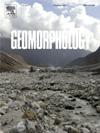Outburst flood events since the Last Glacial Maximum in the Hutiao Gorge of Jinsha River: Geomorphological evidence from eddy gravel bars
Abstract
Breaching of natural dams in the Hutiao Gorge of the Jinsha River across the Yulong-Haba Mountains is one of the major geomorphological events in the largest river of Asia. Catastrophic flood events have an important influence on the geomorphological evolution of the First Bend of the Yangtze River since the Last Glacial Maximum (LGM). However, detailed geomorphological evidence, ages, and depositional phases of outburst flooding remain unclear. In this paper, large-scale gravel bars overlying the river terraces and dammed lakes are analyzed within the Daju Basin. The macroscopic geomorphological characteristics of megaflood landforms with large thickness and uniform gravel bars are similar to those of Missoula and Altai megafloods. Morphological analysis shows that eddy gravel bars (EGBs) with rhythmic structure are characterized by a dome-shaped protrusion in the cross section and a gravel mound in the longitudinal section. Each bar with oblique, parallel and massive bedding was analyzed from the horizontal and vertical directions. Three dome-shaped bars clearly show at least three palaeoflood phases. Quartz grain surface macrotextures are mainly V-shaped pits and conchoidal fractures, which exhibits a high-energy environment during the flood. The stratigraphic sequence model of EGBs is dominated by coarse sand and fine gravel rhythmic bedding in high-energy eddy environments and suspended sand deposits in low-energy backwater environments. Such phenomenon reveals megaflood fluctuates, which is also confirmed by geochemical difference. The episode of natural dam break floods triggered by tectonic activity and glacier fluctuation was dated to 20–17 ka during the LGM. Sedimentary pattern of EGBs offers fresh insights into understanding the megaflood geomorphological characteristics of the upper Yangtze River and better identification similar high-energy palaeoflood landforms in the southeast Tibetan Plateau.

 求助内容:
求助内容: 应助结果提醒方式:
应助结果提醒方式:


